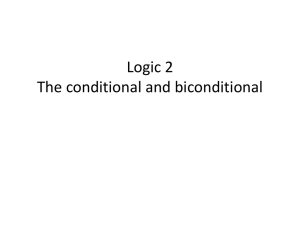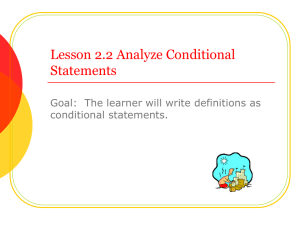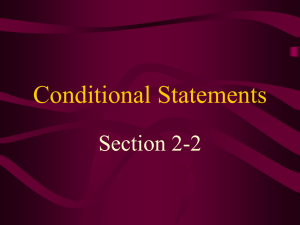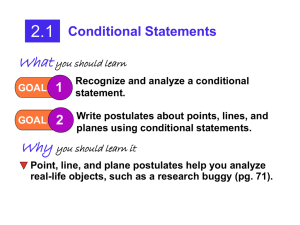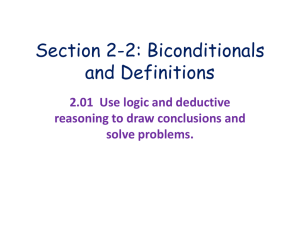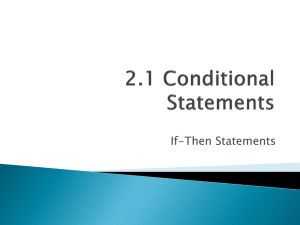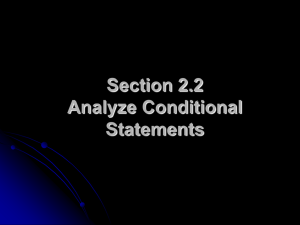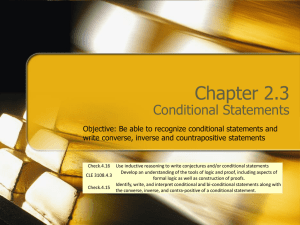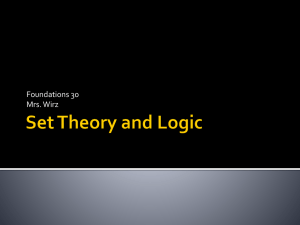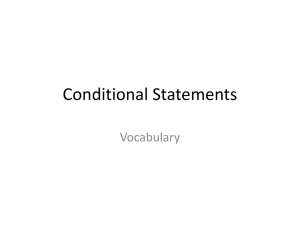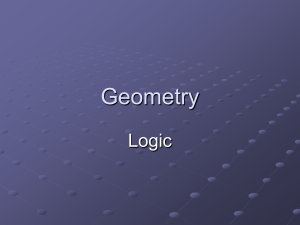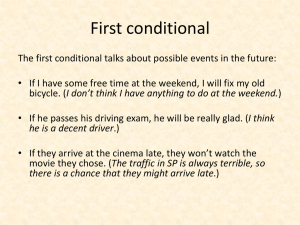3.1 Conditional Statements LESSON
advertisement
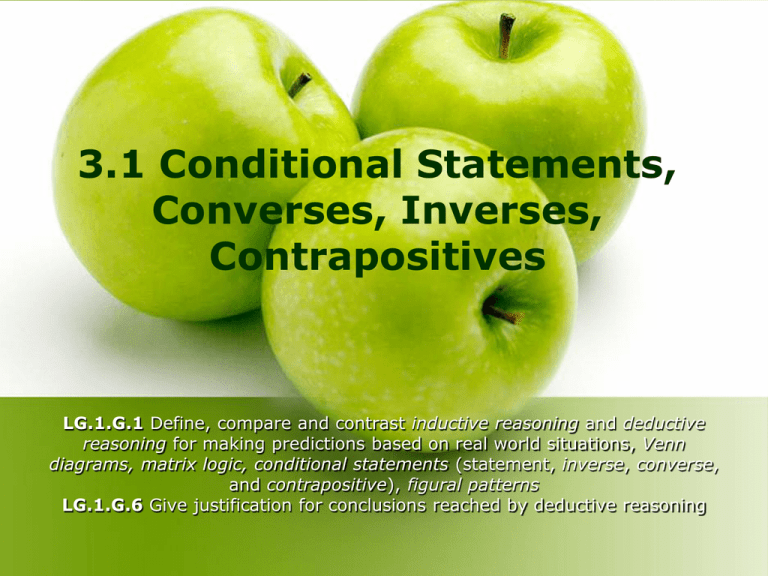
3.1 Conditional Statements, Converses, Inverses, Contrapositives LG.1.G.1 Define, compare and contrast inductive reasoning and deductive reasoning for making predictions based on real world situations, Venn diagrams, matrix logic, conditional statements (statement, inverse, converse, and contrapositive), figural patterns LG.1.G.6 Give justification for conclusions reached by deductive reasoning Conditional Statements If . . . Then Conditional Statement – A compound statement formed by combining two sentences (or facts) using the words “if…then.” Example: If you pass all of your tests, then you will pass the class. Definitions Hypothesis: The part of the sentence that follows the word “IF” Conclusion: The part of the sentence that follows the word “THEN” EXAMPLE: If you do your homework on time, then you will have a better grade. What is the hypothesis? you do your homework on time What is the conclusion? you will have a better grade It may be necessary to rewrite a sentence so that it is in conditional form (“if” first, “then” second). Example: All surfers like big waves. Rewrite as a conditional statement. If you are a surfer, then you like big waves. Truth Value When you determine whether a conditional statement is true or false, you determine its truth value. Counterexamples Counterexample: An example that proves a statement false Write a counterexample for the following conditional statement: If a student likes math, then he likes chemistry. Converse Converse of a Conditional Statement: Formed by interchanging the hypothesis and conclusion of the original statement. Example: Conditional: If the space shuttle was launched, then a cloud of smoke was seen. Converse: If a cloud of smoke was seen, then the space shuttle was launched. HINT Try to associate the logical CONVERSE with Converse sneakers – think of the two parts of the sentence “putting on their sneakers and running to their new positions.” Inverse Inverse of a Conditional Statement: formed by negating the hypothesis and negating the conclusion of the original statement. Put “not” into the hypothesis and the conclusion Example Conditional: If you grew up in Alaska, then you have seen snow. Inverse: If you did not grow up in Alaska, then you have not seen snow. HINT: Hint: To create an INverse, you need to INsert the word not into both the hypothesis and the conclusion. Does the truth value of an inverse have to be the same as the truth value of the original conditional statement? Contrapositive Contrapositive of a Conditional Statement: formed by negating both the hypothesis and the conclusion and then interchanging the resulting negations. Put “not” into the hypothesis and the conclusion, then switch the order. Example Conditional: If 8 is an even number, then 8 is divisible by 2. Contrapositive: If 8 is not divisible by two, then 8 is not an even number. HINT For contrapositive, combine both converse and inverse. The truth value of a contrapositive is ___________________ the original The same as conditional statement. Conditional, Converse, Inverse, and Contrapositive For each statement, write the (a) converse, (b) inverse, and (c) the contrapositive. Give the truth value for each statement. 1. If a student is on the University of Arkansas a b c football team, then he is called a Razorback . TRUE If a student is called a Razorback, then he is on the University of Arkansas football team. FALSE If a student is not on the University of Arkansas football team, then he is not called a Razorback. FALSE If a student is not called a Razorback, then he is not on the University of Arkansas football team. TRUE Conditional, Converse, Inverse, and Contrapositive For each statement, write the (a) converse, (b) inverse, and (c) the contrapositive. Give the truth value for each statement. 2. If a person skateboards well, then they have a good sense of balance. TRUE a b c If a person has a good sense of balance, then they skateboard well. FALSE If a person does not skateboard well, then they do not have a good sense of balance. FALSE If a person does not have a good sense of balance, then they do not skateboard well. TRUE Conditional, Converse, Inverse, and Contrapositive For each statement, write the (a) converse, (b) inverse, and (c) the contrapositive. Give the truth value for each statement. 1. a If it thunderstorms, then our pond overflows. TRUE If our pond overflows, then it has thunderstormed. FALSE b If it does not thunderstorm, then our pond will not overflow. FALSE c If our pond does not overflow, then it has not thunderstormed. TRUE Venn Diagrams A Venn diagram is a drawing used to represent a set of numbers or conditions. Venn diagrams can be useful in explaining conditional statements. Example If you live in Bentonville, then you are a Tiger fan. Hypothesis Conculsion you live in Bentonville you are a Tiger fan Write the conditional statement from the Venn diagram. Equilateral Squares Triangles Triangles with 3 acute angles Quadrilaterals If an object is a square, then it is a quadrilateral. Parallelogram with perpendicular diagonals Rhombus If a triangle is equilateral, then it has three acute angles. If a parallelogram has perpendicular diagonals, then it is a rhombus.
